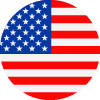Understanding Your Contact Lens Prescription

Wearing contact lenses can come with a difficult learning curve including recognizing the terms and understanding your new contacts prescription. The combination of numbers that encompass the prescription are the precise units that unlock better vision for you.
Thankfully, you can easily decode the meaning of the many abbreviations and terms found on your contact lenses prescription. When it comes to ordering contact lenses online, a valid prescription from a doctor is necessary. Understanding your prescription is the first step you can take to ensure a seamless online ordering experience!
Components of a Contact Lens Prescription
Contact lens prescriptions consist of a small chart or grid, and will feature the following elements: power, base curve, diameter, and brand. Power refers to the strength of the lens prescription, diameter refers to the width of the contact lens, and base curve refers to the curvature of the lens. The brand represents the actual brand or manufacturer that makes the contact lens.
These are all important factors to consider when selecting and fitting contact lenses. Additionally, you will find on your contact lenses prescription the terms “OS” which stands for "oculus sinister," translating to “left eye” in Latin. Similarly, you’ll see the abbreviation “OD,” or "oculus dextrus," which means “right eye” in Latin. These are commonly used abbreviations in optometry and ophthalmology.
Additionally, your prescription could also include the term “ADD” which stands for “additional correction” and can refer to multifocal, bifocal, or progressive lenses. Finally, multifocal contacts lenses will sometimes offer the term “D/N,” which denotes dominant or non-dominant eye.
Power
Power (PWR) refers to the strength of the lens prescription and is represented with a number. This component can also be represented by the acronym (SPH) or spherical correction. This refraction power is the unit of measurement used for this component. The more negative the number, the higher the level of nearsightedness correction. When there is a positive number in this field, this represents farsightedness. It is common that one eye can have a certain number and the other can have another. Having an updated power measurement is important as the numbers help provide correction to get as close to 20/20 vision as possible.
Base Curve
The base curve, that reads “BC” on the prescription, of a contact lens refers to the curvature of the back surface of the lens. It determines how well the lens fits on the eye. In a typical prescription, this number falls between 8 and 9. A proper fit ensures that the lens stays in place and provides clear vision, without causing discomfort or damage to the eye. Base curve is not a part of an eyeglasses prescription, therefore contact lens prescriptions are not interchangeable when ordering glasses.
Diameter
Diameter (DIA) refers to the width of the contact lens. This distance is measured from one edge of the contact lens to the other and is measured in millimeters. This number generally falls between 13 and 15 and ensures that the contact lens fits comfortably over your cornea.
Brand
Brands of contact lens are important to your prescription as each brand is specific to the fit and measurements based on what your optometrist recommends. Initially, your optometrist will fit you for lenses and will prescribe a correlating brand that fits your prescription. You are not necessarily beholden to the brand forever. If you would like to try a new brand you can check with your optometrist first. Schedule an eye exam to ensure the new brand is the proper fit as each prescription is individual to one brand manufacturer.
Interpreting and Inputting Your Prescription
You will find that interpreting and understanding your contact lens prescriptions come easier over time. The information on the side of the contact lens box provides universal details that translate to different eye care providers, retailers, sellers, and online shops. Once you take the initiative to begin ordering your contacts online, you will start by consulting with your eye doctor and requesting a prescription. Then, you can purchase contact lenses with a prescription from an online retailer like Hubble or a local store. Make sure to provide accurate and up-to-date information to ensure you receive the correct lenses.
Here are some tips for a seamless online ordering experience:
- Obtain a valid contact lens prescription from your eye doctor.
- Your contact lens prescription can be found on the side of the contact lens box from a previous order. Your doctor may have also provided a written copy of this prescription.
- The terms, abbreviations, and numbers are useful and hold the key to ordering new contacts lenses online when you have this information. Your contact lens prescription includes your name, the date of prescription expiration, the prescriber's name, and, for the lenses themselves, power, base curve, manufacturer, diameter, and material.
- Visit a reputable online retailer that sells contact lenses.
- Enter your prescription information and select the type of contacts you want to order
- For re-ordering or new prescriptions, it is important that your contact lens prescription is accurate and updated. Remember that regular eye care and consistent regular vision check ups will ensure your prescription remains unexpired and current.
- Communicating with the prescribing doctor is required by law for all companies that sell contact lenses. This is because the tiny lenses you're placing in your eyes are actual medical devices.
- Avoid using retailers that boast claims of fulfilling contact lens orders without a prescription.
- Ordering contacts through Hubble or our sister site ContactsCart ensures an endless choice in contact lens brands that fit your needs. If you are looking for contacts for astigmatism, toric lenses, 90-day supplies, or even color lenses, discover many types of lenses available with the best fit for your eyes
Contact Lens Prescription Frequently Asked Questions
Can I Use My Glasses Prescription for Contact Lenses?
Eyeglasses sit at a slightly longer distance away from your eyes And contact lenses rest directly on the eye providing a more accurate vision correction. Glasses prescriptions should not be used in lieu of the contact lens prescription. Contact lenses are also specific to brands unlike glasses. Also, base curve and diameter are not a part of an eyeglasses prescription, therefore contact lens prescriptions are not interchangeable when ordering glasses.
What Prescription Can Contact Lenses Go To?
Contact lens prescriptions can also address conditions like astigmatism (the condition where the eye has an irregular shape. There are special toric contact lenses designed for people with astigmatism. CYL or cylinder power will be indicated on the contact lens prescription. This is measured in a unit called diopters and is a number usually from -4 to +4.
The term "axis" on contact lenses refers to the orientation of the lens, specifically for correcting astigmatism. It indicates the location of the meridian on the lens that has no power, and is typically measured in degrees ranging from 0 to 180. Usually toric lenses will reflect this number. It is important to get a proper fitting from an eye care professional to ensure the contact lenses are comfortable and provide improved vision.
How Long Are Contacts Prescriptions Valid For?
Contact lens prescriptions typically expire anywhere from one year at minimum up to two years depending on the state. Your prescriber provides you with a copy of your prescription after completing your eye exam and will include an expiration date. Your prescription can be digitally sent to you as well. 184. Plus, it can be taken from the comfort of your own home using your own device, in 10 minutes or less.
You can find many more of your contact lens questions answered for you here on our Frequently Asked Questions section.
Ordering Contacts Made Easy with Hubble
Your contact lens prescription is packed with practical information and facts that help to enhance your vision and ensure proper visual correction. At Hubble, customers will find their prescription fits with the availability of selection and brands. You can order from Hubble even without a paper copy of your prescription. Once you decide on contact lenses, you'll enter your prescription and select your preferred lens type.
To get the most out of your contact lenses—and save some time on contact lens care—try daily contacts from Hubble. Start your daily contact lens subscription with Hubble’s classic lenses with a 15-day starter pack for only $1, or with new Hyrdo by Hubble Lenses, with a 40% off offer for new customers.
Hubble’s classic lenses are made from methafilcon A, a hydrogel material. With 55% water content, UV protection, and a thin edge, they're designed for easy insertion, all-day comfort and crystal clear vision. New Hydro by Hubble Lenses are just as comfortable, and made with tear-bonding materials that keep your eyes hydrated and comfortable all day long.



